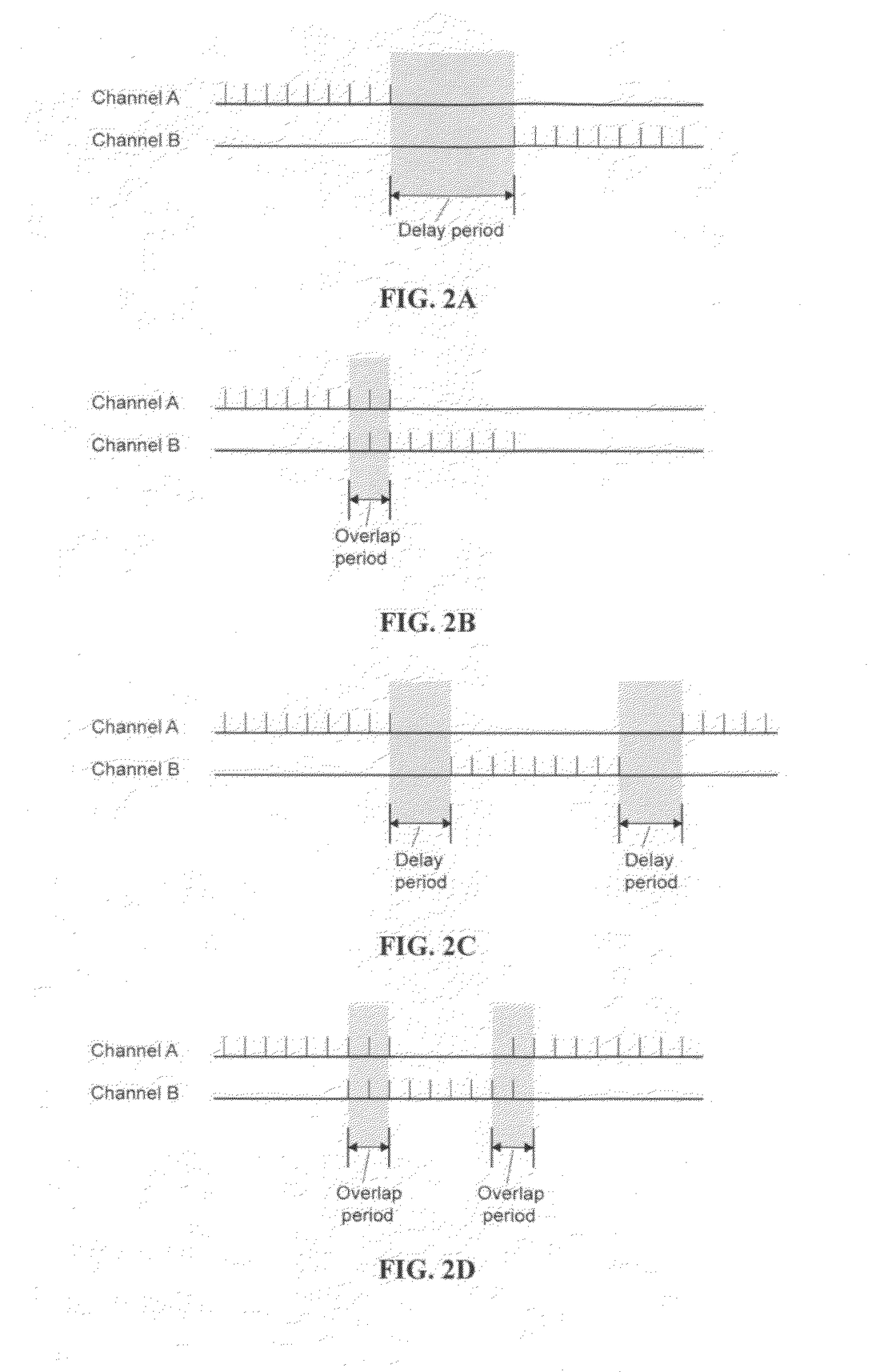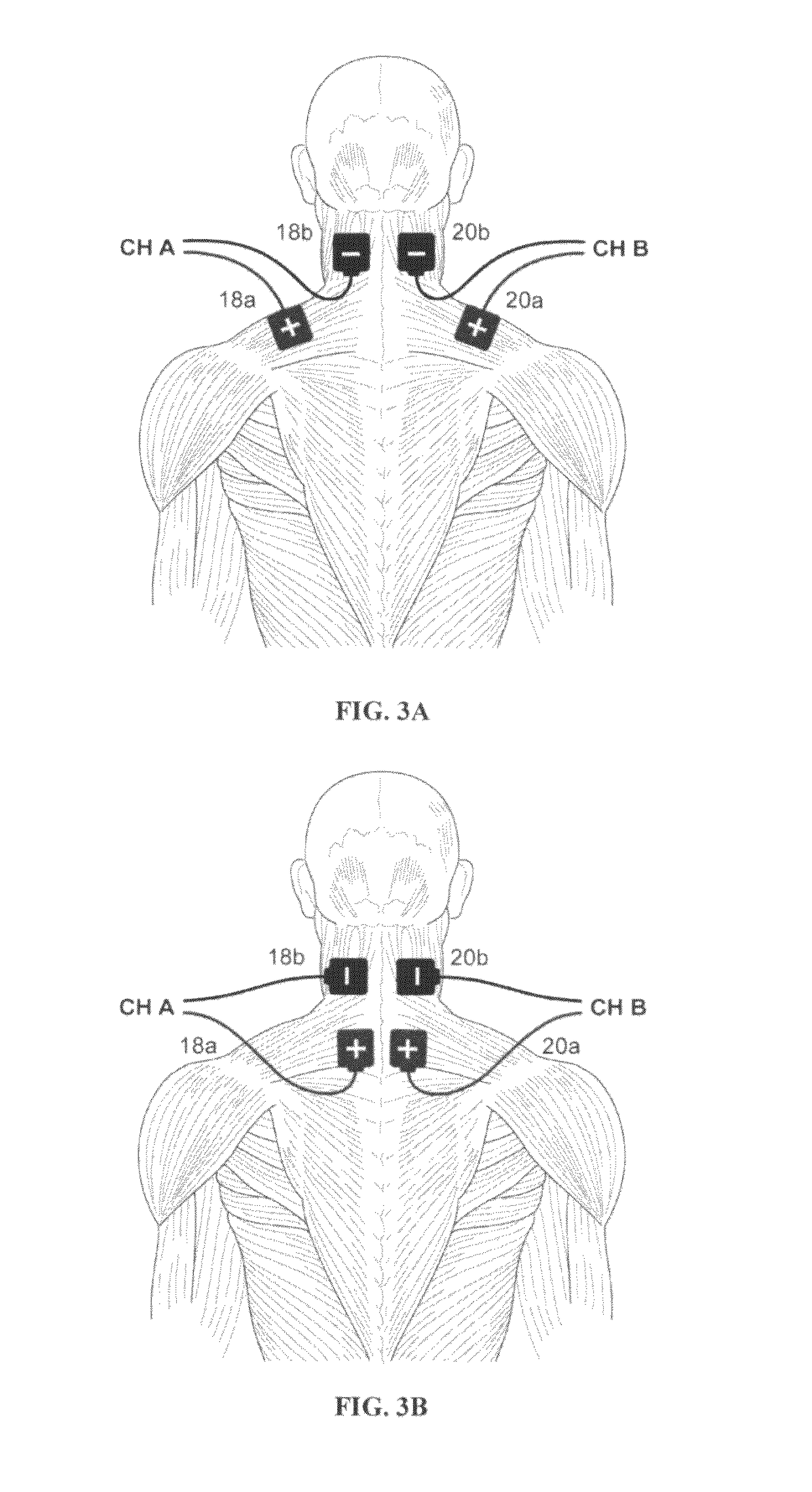Electrical stimulation method for reduction of joint compression
a joint compression and electric stimulation technology, applied in electrotherapy, external electrodes, therapy, etc., can solve the problems of joint pain and/or stiffness, joint deformation, degeneration or “wear and tear” of articular cartilage, etc., to reduce joint compression and reduce co-contraction
- Summary
- Abstract
- Description
- Claims
- Application Information
AI Technical Summary
Benefits of technology
Problems solved by technology
Method used
Image
Examples
first exemplary embodiment
[0102]In a first exemplary embodiment of the present invention, as generally illustrated in FIG. 3A, a pair of electrodes is positioned in electrical contact with the patient's tissue in order to provide electrical stimulation to one or more of the muscles associated with intervertebral and shoulder joint movement. A second pair of electrodes is positioned bilaterally in a similar manner.
[0103]More specifically, as shown in FIG. 3A, a two-channel system is used to apply electrical stimulation to agonist / antagonist muscles involved in neck intervertebral and shoulder joint movement. For the first channel, a first electrode 18a is positioned in electrical contact with tissue to stimulate a motor point of the patient's upper trapezius muscle. Most preferably, first electrode 18a comprises a surface electrode that is positioned on the patient's skin along the midpoint of the upper trapezium. A second electrode 18b is positioned is electrical contact with tissue to stimulate a motor poin...
second exemplary embodiment
[0114]In a second exemplary embodiment of the present invention, as generally illustrated in FIG. 3B, two pairs of electrodes are positioned in electrical contact with the patient's tissue in order to provide electrical stimulation to one or more of the muscles associated with intervertebral and shoulder joint movement
[0115]More specifically, as shown in FIG. 3B, a two-channel system is used to apply electrical stimulation to agonist / antagonist muscles involved in neck intervertebral and shoulder joint movement. For the first channel, a first electrode 118a is positioned in electrical contact with tissue to stimulate a motor point of the patient's lower cervical and upper thoracic paraspinal muscles. Most preferably, first electrode 18a comprises a surface electrode that is positioned on the patient's skin along the midpoint of the upper trapezius just lateral to the spinal cord, most preferably near the C6, C7, T1, T2, T3, and / or T4 cervical and thoracic vertebrae. A second electro...
third exemplary embodiment
[0126]In a third exemplary embodiment of the present invention, as generally illustrated in FIG. 3C, two pairs of electrodes are positioned in electrical contact with the patient's tissue in order to provide electrical stimulation to one or more of the muscles associated with intervertebral joint movement.
[0127]More specifically, as shown in FIG. 3C, a two channel system is used to apply electrical stimulation to agonist / antagonist muscles involved in upper and mid-back intervertebral joint movement including the erector spinae and trapezius muscles. For the first channel, a first electrode 18a is positioned in electrical contact with tissue to stimulate a motor point of the patient's thoracic paraspinal muscles. Most preferably, first electrode 18a comprises a surface electrode that is positioned on the patient's skin just lateral to one or more thoracic vertebrae, most preferably near the T3, T4, T5, T6, T7, T8, and / or T9 thoracic vertebrae. A second electrode 18b is positioned in...
PUM
 Login to View More
Login to View More Abstract
Description
Claims
Application Information
 Login to View More
Login to View More - R&D
- Intellectual Property
- Life Sciences
- Materials
- Tech Scout
- Unparalleled Data Quality
- Higher Quality Content
- 60% Fewer Hallucinations
Browse by: Latest US Patents, China's latest patents, Technical Efficacy Thesaurus, Application Domain, Technology Topic, Popular Technical Reports.
© 2025 PatSnap. All rights reserved.Legal|Privacy policy|Modern Slavery Act Transparency Statement|Sitemap|About US| Contact US: help@patsnap.com



